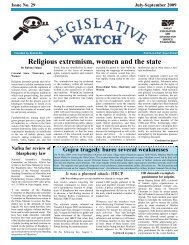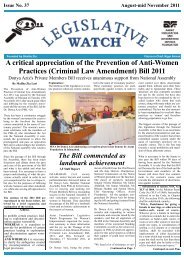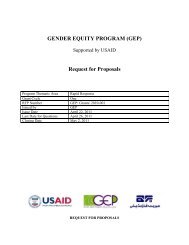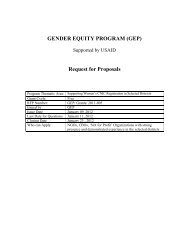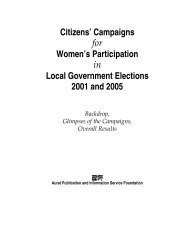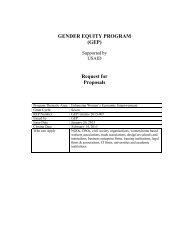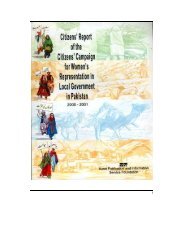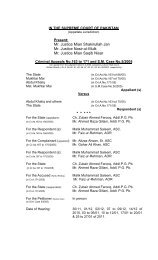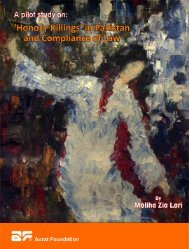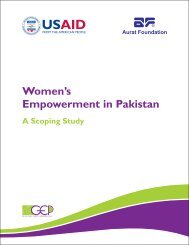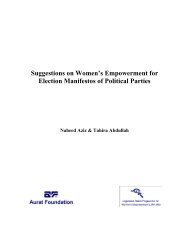Legislative Quotas for Women: A global and ... - Aurat Foundation
Legislative Quotas for Women: A global and ... - Aurat Foundation
Legislative Quotas for Women: A global and ... - Aurat Foundation
- No tags were found...
Create successful ePaper yourself
Turn your PDF publications into a flip-book with our unique Google optimized e-Paper software.
The quota is also intended to reduce to the minimum level all theobstacles - political, economic <strong>and</strong> ideological - in the path of women’sprogress <strong>and</strong> to overcome prejudices that prevent women from enteringinto the political arena.<strong>Quotas</strong> are implemented in many ways <strong>and</strong> the quota targets (per cent ornumber of women) may vary from country to country. Through quotasthe target may be fixed at a certain percentage, <strong>for</strong> example, 30 per centor at a number like 15 women from every district or province. It may alsobe decided that quotas will apply at different stages of the selectionprocess (<strong>for</strong> example, they will apply in the nomination process or at theend of the selection process of election c<strong>and</strong>idates). Similarly, onecountry may have several quota types.In the same manner gender quotas can be introduced at any level of thepolitical system: federal, national, regional or local. Some examples ofstrong quota regimes at the local level are the 50 percent quotas at thelocal level in France <strong>and</strong> the 20-33 percent gender quota <strong>for</strong> localcouncils in India, Pakistan <strong>and</strong> Bangladesh.Quota system can claim many good things like <strong>for</strong> example it places theburden of recruitment not on the individual woman, but on those whocontrol the recruitment process. The main idea behind this system is thatit not only recruits women into political positions but also ensures thatwomen are not only a token few in political life.According to the Quota Project, which is a joint venture between theInternational Institute <strong>for</strong> Democracy <strong>and</strong> Electoral Assistance (IDEA),<strong>and</strong> Stockholm University’s Department of Political Science, by 2008,around 40 countries had introduced legal c<strong>and</strong>idate quotas <strong>for</strong>parliamentary, regional or local elections in their constitution or in theirelectoral law or party law. In another 50 countries, major political partieshad introduced gender quotas when compiling their party lists <strong>for</strong> election(so-called voluntary party c<strong>and</strong>idate quotas). C<strong>and</strong>idate quotas imply thata minimum, of say 30 or 40 percent, of the c<strong>and</strong>idates <strong>for</strong> election mustbe women. The most common proportion is 30 percent women, althoughsome are set at 50 percent.20



